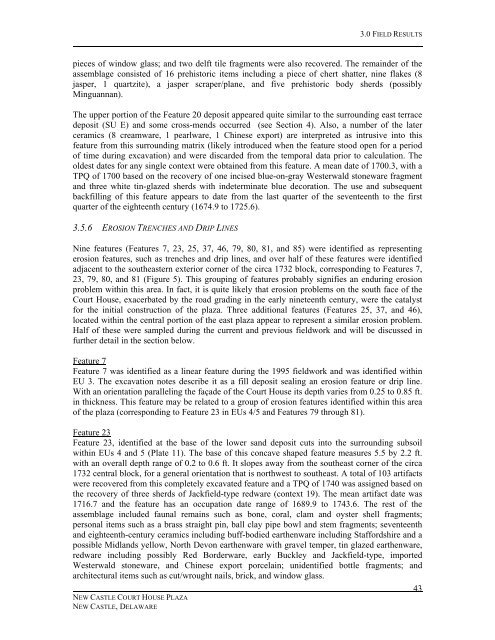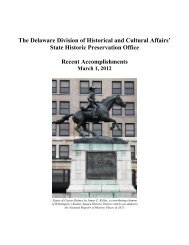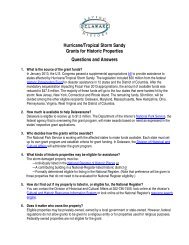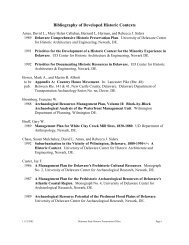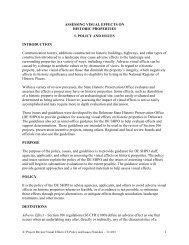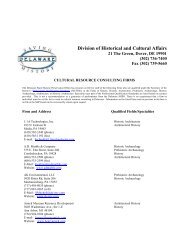Report of the Archaeological Investigations of the New Castle Court ...
Report of the Archaeological Investigations of the New Castle Court ...
Report of the Archaeological Investigations of the New Castle Court ...
You also want an ePaper? Increase the reach of your titles
YUMPU automatically turns print PDFs into web optimized ePapers that Google loves.
NEW CASTLE COURT HOUSE PLAZA<br />
NEW CASTLE, DELAWARE<br />
3.0 FIELD RESULTS<br />
pieces <strong>of</strong> window glass; and two delft tile fragments were also recovered. The remainder <strong>of</strong> <strong>the</strong><br />
assemblage consisted <strong>of</strong> 16 prehistoric items including a piece <strong>of</strong> chert shatter, nine flakes (8<br />
jasper, 1 quartzite), a jasper scraper/plane, and five prehistoric body sherds (possibly<br />
Minguannan).<br />
The upper portion <strong>of</strong> <strong>the</strong> Feature 20 deposit appeared quite similar to <strong>the</strong> surrounding east terrace<br />
deposit (SU E) and some cross-mends occurred (see Section 4). Also, a number <strong>of</strong> <strong>the</strong> later<br />
ceramics (8 creamware, 1 pearlware, 1 Chinese export) are interpreted as intrusive into this<br />
feature from this surrounding matrix (likely introduced when <strong>the</strong> feature stood open for a period<br />
<strong>of</strong> time during excavation) and were discarded from <strong>the</strong> temporal data prior to calculation. The<br />
oldest dates for any single context were obtained from this feature. A mean date <strong>of</strong> 1700.3, with a<br />
TPQ <strong>of</strong> 1700 based on <strong>the</strong> recovery <strong>of</strong> one incised blue-on-gray Westerwald stoneware fragment<br />
and three white tin-glazed sherds with indeterminate blue decoration. The use and subsequent<br />
backfilling <strong>of</strong> this feature appears to date from <strong>the</strong> last quarter <strong>of</strong> <strong>the</strong> seventeenth to <strong>the</strong> first<br />
quarter <strong>of</strong> <strong>the</strong> eighteenth century (1674.9 to 1725.6).<br />
3.5.6 EROSION TRENCHES AND DRIP LINES<br />
Nine features (Features 7, 23, 25, 37, 46, 79, 80, 81, and 85) were identified as representing<br />
erosion features, such as trenches and drip lines, and over half <strong>of</strong> <strong>the</strong>se features were identified<br />
adjacent to <strong>the</strong> sou<strong>the</strong>astern exterior corner <strong>of</strong> <strong>the</strong> circa 1732 block, corresponding to Features 7,<br />
23, 79, 80, and 81 (Figure 5). This grouping <strong>of</strong> features probably signifies an enduring erosion<br />
problem within this area. In fact, it is quite likely that erosion problems on <strong>the</strong> south face <strong>of</strong> <strong>the</strong><br />
<strong>Court</strong> House, exacerbated by <strong>the</strong> road grading in <strong>the</strong> early nineteenth century, were <strong>the</strong> catalyst<br />
for <strong>the</strong> initial construction <strong>of</strong> <strong>the</strong> plaza. Three additional features (Features 25, 37, and 46),<br />
located within <strong>the</strong> central portion <strong>of</strong> <strong>the</strong> east plaza appear to represent a similar erosion problem.<br />
Half <strong>of</strong> <strong>the</strong>se were sampled during <strong>the</strong> current and previous fieldwork and will be discussed in<br />
fur<strong>the</strong>r detail in <strong>the</strong> section below.<br />
Feature 7<br />
Feature 7 was identified as a linear feature during <strong>the</strong> 1995 fieldwork and was identified within<br />
EU 3. The excavation notes describe it as a fill deposit sealing an erosion feature or drip line.<br />
With an orientation paralleling <strong>the</strong> façade <strong>of</strong> <strong>the</strong> <strong>Court</strong> House its depth varies from 0.25 to 0.85 ft.<br />
in thickness. This feature may be related to a group <strong>of</strong> erosion features identified within this area<br />
<strong>of</strong> <strong>the</strong> plaza (corresponding to Feature 23 in EUs 4/5 and Features 79 through 81).<br />
Feature 23<br />
Feature 23, identified at <strong>the</strong> base <strong>of</strong> <strong>the</strong> lower sand deposit cuts into <strong>the</strong> surrounding subsoil<br />
within EUs 4 and 5 (Plate 11). The base <strong>of</strong> this concave shaped feature measures 5.5 by 2.2 ft.<br />
with an overall depth range <strong>of</strong> 0.2 to 0.6 ft. It slopes away from <strong>the</strong> sou<strong>the</strong>ast corner <strong>of</strong> <strong>the</strong> circa<br />
1732 central block, for a general orientation that is northwest to sou<strong>the</strong>ast. A total <strong>of</strong> 103 artifacts<br />
were recovered from this completely excavated feature and a TPQ <strong>of</strong> 1740 was assigned based on<br />
<strong>the</strong> recovery <strong>of</strong> three sherds <strong>of</strong> Jackfield-type redware (context 19). The mean artifact date was<br />
1716.7 and <strong>the</strong> feature has an occupation date range <strong>of</strong> 1689.9 to 1743.6. The rest <strong>of</strong> <strong>the</strong><br />
assemblage included faunal remains such as bone, coral, clam and oyster shell fragments;<br />
personal items such as a brass straight pin, ball clay pipe bowl and stem fragments; seventeenth<br />
and eighteenth-century ceramics including buff-bodied ear<strong>the</strong>nware including Staffordshire and a<br />
possible Midlands yellow, North Devon ear<strong>the</strong>nware with gravel temper, tin glazed ear<strong>the</strong>nware,<br />
redware including possibly Red Borderware, early Buckley and Jackfield-type, imported<br />
Westerwald stoneware, and Chinese export porcelain; unidentified bottle fragments; and<br />
architectural items such as cut/wrought nails, brick, and window glass.<br />
43


